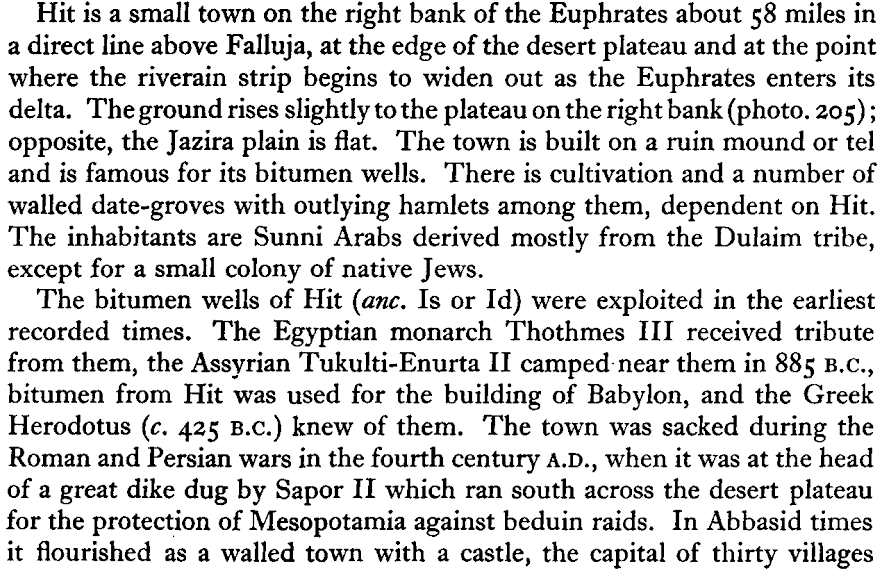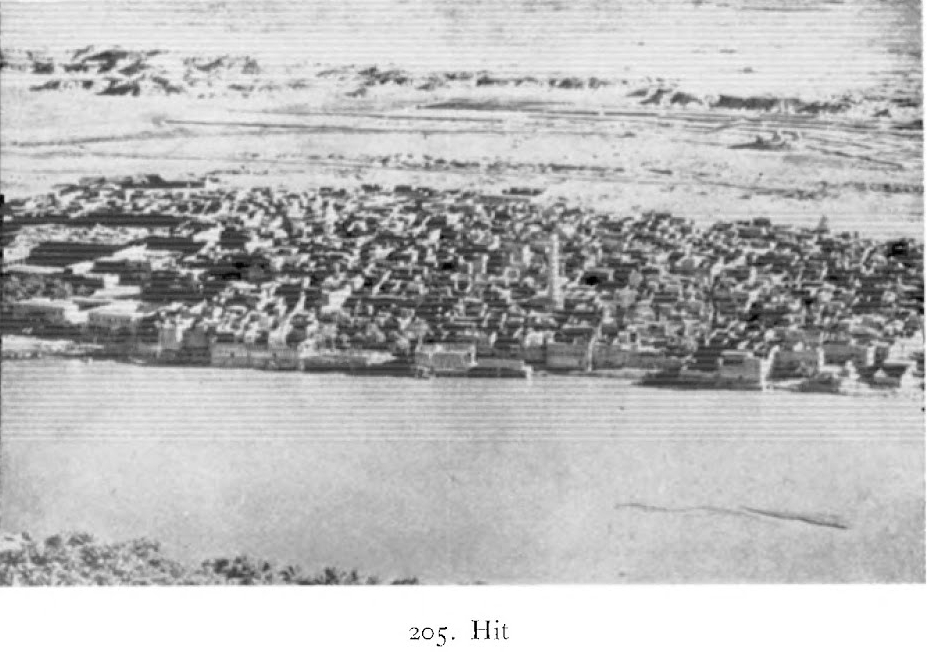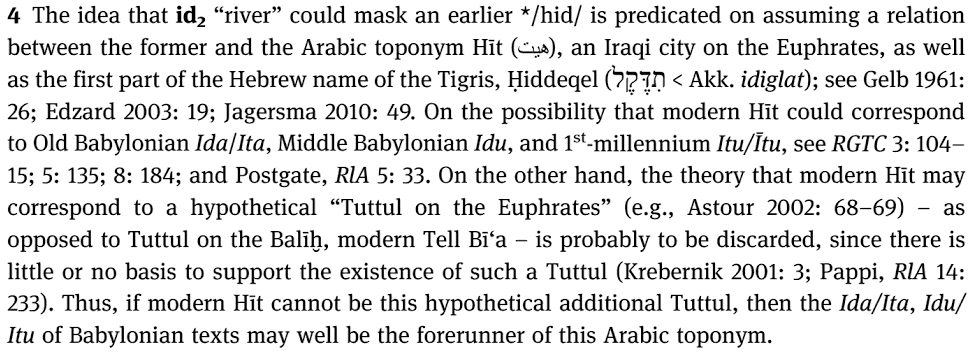|
Other Archaeological Sites / The Neolithic of the Levant (500 Page Book Online) Old Babylonian Hīt in Iraq on the Euphrates River The Ancient Is of Herodotus: See Page 70 in (A) and Page 98 in (B)
The (Arabic هيت) named Hīt is a small walled town near the site of the ancient city of Is. In ancient times the area was known for its bitumen wells which were used more than 3500 years ago to include the building of Babylon and for caulking boats. Is also became a frontier fortress for Assyria. Now present day Hīt is a marketplace for agricultural produce and oil pipelines to the Mediterranean Sea which cross the Euphrates there (1). (8) Pages 534-5 in Iraq & The Persian Gulf --- Naval Intelligence Division (Routledge 2014)
(2) 037 Is also known as Hīt --- Cultural Property Training Resource (Iraq) Dates: Old Babylonian (circa 1800 BC) to modern times Approximately one kilometer southwest of the outskirts of the modern city of Hīt
[The wadi or bitumen spring or creek that fed into the Euphrates River
The name is first encountered in Old Babylonian texts in the Mari letters although it may be mentioned in Akkadian times with the name Tuttul. In Middle and Neo-Assyrian texts (circa 1100-600 BC) it is listed as making contributions to the capital and was among other towns on the Euphrates which functioned as frontier fortresses for Assyria.
Hīt: a border city on the Euphrates between the kingdoms of Mari and Babylon during the time of Hammurabi. The balance of power that existed in Mesopotamia in the first half of the reign of Hammurabi was partly maintained by the tacit agreement that all kings in the region accepted the superiority of the king of Elam. The king of Elam had ruled that Hīt would be the property of Mari. The disagreement over who controlled Hīt would hang over relations between Hammurabi and Zimri- Lim of Mari. The negotiations over the city started in 1770 B.C. The exchange indicates that Hammurabi was unwilling to give up his claim although Zimri-Lim was a good and trusted ally. He urged his colleague to share power in Hit as they had done in Rapiqum. He could not press his claim too hard since Elam was still the greatest power in the region. But that changed when Elam’s friendly relations with Babylon and Mari ended and hostilities erupted in 1765. The impending war against Elam gave Hammurabi an opening to reject its earlier decision but he was confronted with a dilemma. On the one hand he was eager to press Mari on the matter of Hit; on the other hand he needed Mari as an ally against Elam. Two tracks of negotiations were thus opened at the same time. Mari had been reluctant to cut its ties with Elam but went over to Hammurabi’s camp after its own northern territories were threatened by that country. Both kings swore an oath to an anti-Elam treaty and the two armies joined forces (Pages 67-71 in 5) ...
Id, modern Hīt, was on the border between the kingdoms of Mari and Babylon. Bitumen wells
in its vicinity provided the widely used sealant for boats and waterproof containers
and were the scene of the so-called “river ordeals”. Possession of Id was contested
between Mari and Babylon Note: The Trial by the Divine River was widely practice in the Ancient Near East (Mari) as a method of divine judgment in cases where there was no evidence of guilt (Page 10 in 7) ... ... On the twenty-sixth we passed by very beautiful and fertile country in which was situated a little hamlet; thence before nightfall we came to Ith (sic) or Hīt, a very ancient town with a castle about a mile away. There is a great spring from which flows bitumen in large quantities, even the surrounding soil and pebbles contain bitumen and the inhabitants of the country say that when the Tower of Babylon was being built bitumen was fetched from there. This spring is horrible by reason of its black bubbling water and is commonly known as the “mouth of hell”. The surrounding fields produce large quantities of saltpetre (Page 87 in 3) ...
(1) Hīt --- The New Encyclopædia Britannica 1980 Page 66
(2) 037 Is also known as Hīt --- Cultural Property Training Resource (Iraq)
(3) Sir Anthony Sherley and His Persian Adventure by E. Denison Ross (Routledge Publisher) 2004
(4) The First Ninety Years: A Sumerian Celebration in Honor of Miguel Civil
(5) King Hammurabi of Babylon: A Biography by Marc Van De Mieroop (2008)
(6) Letters to the King of Mari: A New Translation with Historical Introduction Notes and Commentary
(7) LEGAL CONTEXT OF THE LAKE OF FIRE --- 2017 Compton College (Women In Industry & Technology Resources)
(8) Iraq & The Persian Gulf --- Naval Intelligence Division (Routledge 2014)
See Also: Hīt: ancient name Is is an Iraqi city in Al-Anbar province (WikiPedia)
|







